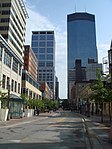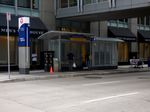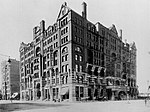33 South Sixth
Leadership in Energy and Environmental Design basic silver certified buildingsOffice buildings completed in 1983Skidmore, Owings & Merrill buildingsSkyscraper office buildings in Minneapolis

33 South Sixth, formerly known as International Multifoods Tower, is a skyscraper in Minneapolis, Minnesota. It was designed by Skidmore, Owings and Merrill and stands 52 stories tall at 668 ft (204 m). Its name comes from its address: 33 South Sixth Street, Minneapolis. It was completed in 1983 as headquarters for International Multifoods Corporation which occupied the structure until 1997 when it moved to suburban Wayzata. Although the corporate offices relocated, the name remained until 2003 under the terms of its lease. Adjacent to the tower is the Minneapolis City Center shopping mall which occupies the ground level, skyway, and third levels.
Excerpt from the Wikipedia article 33 South Sixth (License: CC BY-SA 3.0, Authors, Images).33 South Sixth
South 6th Street, Minneapolis
Geographical coordinates (GPS) Address External links Nearby Places Show on map
Geographical coordinates (GPS)
| Latitude | Longitude |
|---|---|
| N 44.978055555556 ° | E -93.272777777778 ° |
Address
33 S Sixth
South 6th Street 33
55402 Minneapolis
Minnesota, United States
Open on Google Maps










